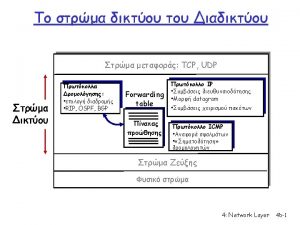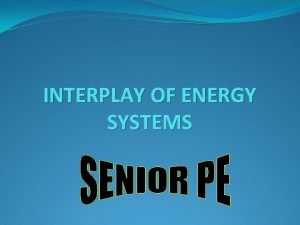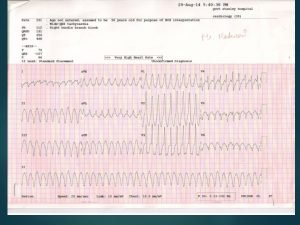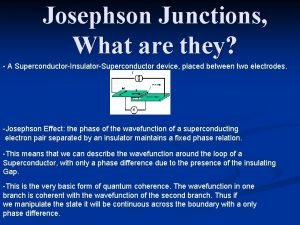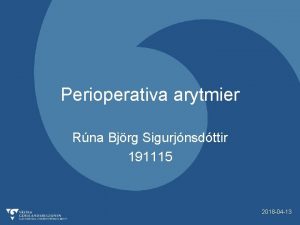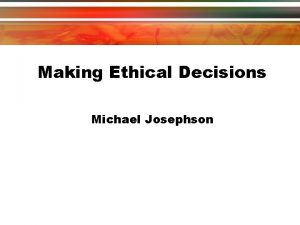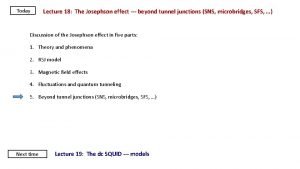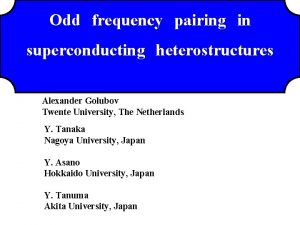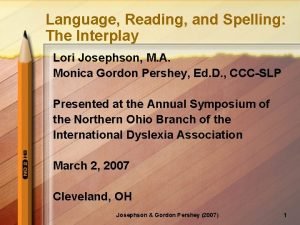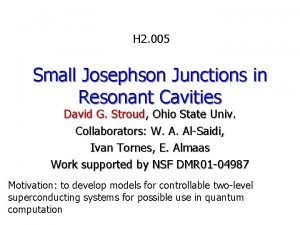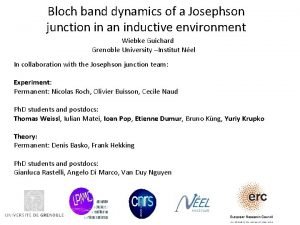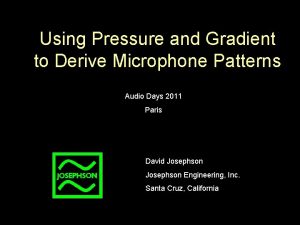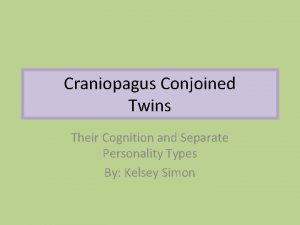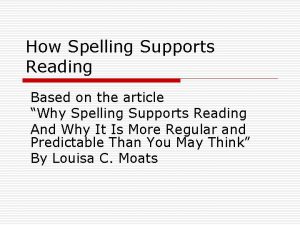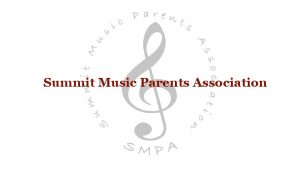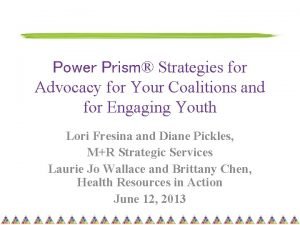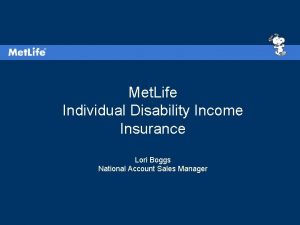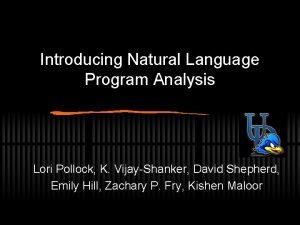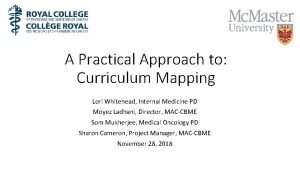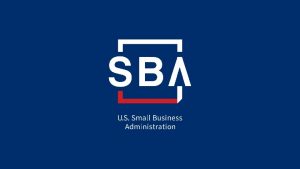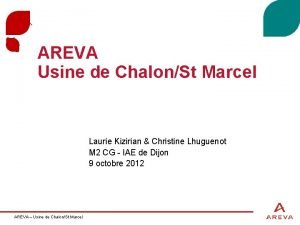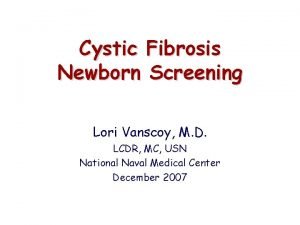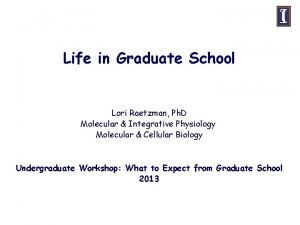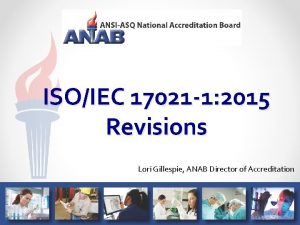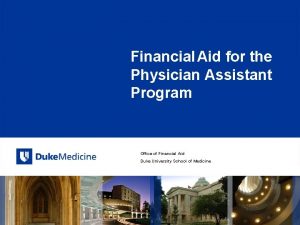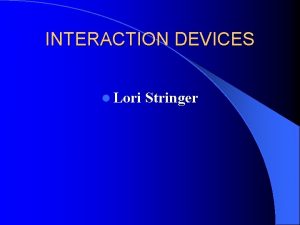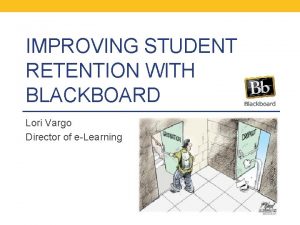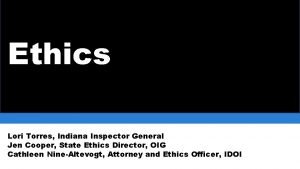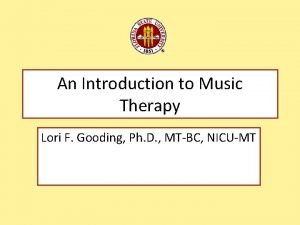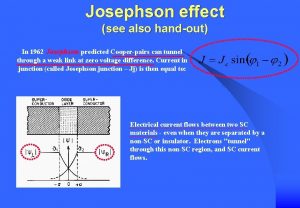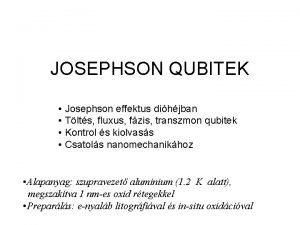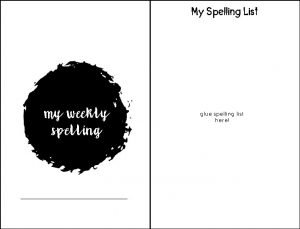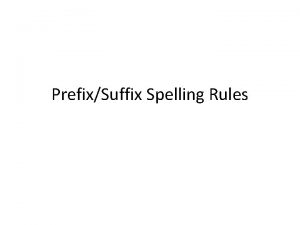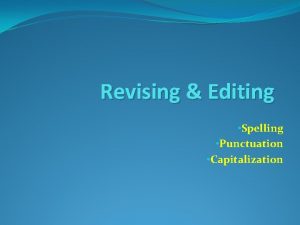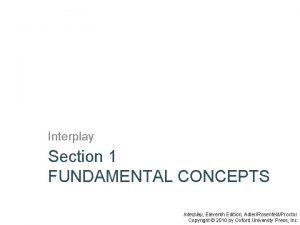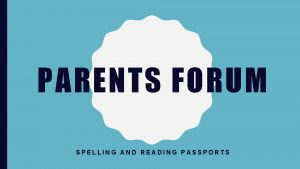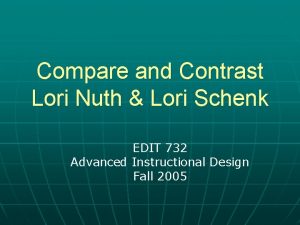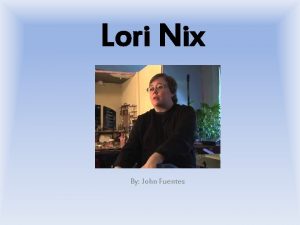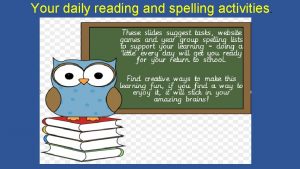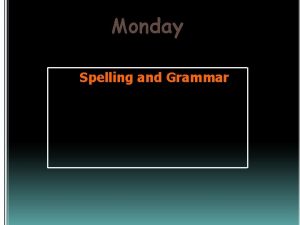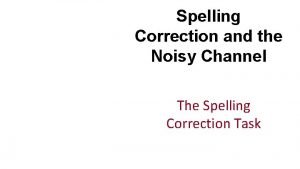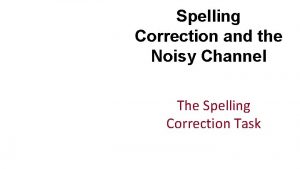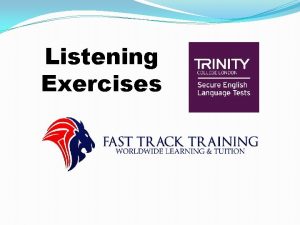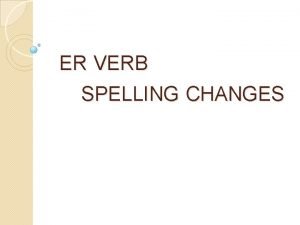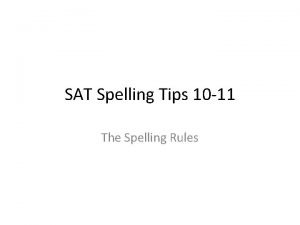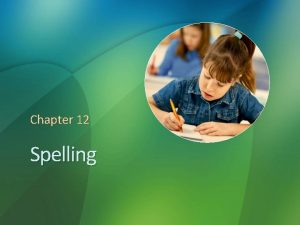Language Reading and Spelling The Interplay Lori Josephson



































































- Slides: 67

Language, Reading, and Spelling: The Interplay Lori Josephson, M. A. Monica Gordon Pershey, Ed. D. , CCC-SLP Presented at the Annual Symposium of the Northern Ohio Branch of the International Dyslexia Association March 2, 2007 Cleveland, OH Josephson & Gordon Pershey (2007) 1

Oral Language: Connection to Academics Oral Language Forms the Underpinnings for the “Essential Components of Reading Instruction”: – Phonemic Awareness – Phonics – Vocabulary Development – Reading Fluency (Oral & Silent) – Reading Comprehension Strategies Josephson & Gordon Pershey (2007) 2

Oral Language: Connection to Academics Development of Written Language Skills: – Spelling – Writing to the Audience – Sentence Structure (Syntax/Grammar) – Retrieval of Oral Vocabulary – Sequencing (Phonemes, Words, Ideas) – Organization of Thought – Active Working Memory: Remembering What You’ve Written and What You Still Want to Write Josephson & Gordon Pershey (2007) 3

Oral Language: Connection to Academics Content Area Instruction – The Language of Mathematics l Vocabulary l Syntax l Multiple Meanings – Social Studies/Science l Vocabulary l Abstract Thinking l Precise Observation/ Measurement l Drawing Conclusions Josephson & Gordon Pershey (2007) 4

Oral Language: Three Systems Semantics = “Content” - Making Meaning - Vocabulary - Specialized Lexicon - Concept Development - Breadth, Depth, and Connections - Contextual Usage and Analysis of Words - Structural Analysis of Words Josephson & Gordon Pershey (2007) 5

Oral Language: Three Systems Syntax = “Form” - Phonology: Phonemes, Syllables, Intonation, Stress, Pauses - Content Words: Nouns, Verbs, Adjectives, Adverbs - Function Words: Preposition, Conjunction, Auxiliary Verb, Article, Pronouns - Morphology: Affixes, Inflection, Contractions - Word Order: Clauses, Sentence Types, Question Words, Negation Josephson & Gordon Pershey (2007) 6

Oral Language: Three Systems Pragmatics = “Use” = In Context - Message Function: Intent and Purpose (To Inform, To Question, To Joke, To Form Attachment) - Message Cohesion: Successive Utterances Follow Logically, Maintain a Topic, Change a Topic, Lead Up to a Point, Sequence - Discourse: A Text (A Passage, A Book, An Advertisement, A Conversation, A Movie); A Genre Josephson & Gordon Pershey (2007) 7

Oral Language: Three Systems Linguistic Clarity Meet the Informational Needs of the Listener Logical Sequence Economy Expressivity Self-Monitoring Executive Function Social/Cultural/ Gender/Age/Setting/ Interlocutors Cooperation Turn-Taking Politeness Status/Role Topic Selection Nonverbal Language Self-Monitoring Executive Function Josephson & Gordon Pershey (2007) 8

Oral Language: Three Systems l l Pragmatic skill is judged by criteria of social validity - success in a social field Listener evaluations are dependent upon culturally conditioned values that dictate credibility: wealth, appearance, physical fitness Linguistic/cognitive competence may or may not predict social competence Social competence may mask linguistic/cognitive deficits Josephson & Gordon Pershey (2007) 9

Oral Language: Three Systems Bloom, L. Pediatrics 1998; 102: e 1272 Copyright © 1998 American Academy of Pediatrics Josephson & Gordon Pershey (2007) 10

Form l l l Articulation/Auditory Discrimination Phonological Processing/Phonemic Awareness – Manipulation Affects Reading/Spelling (Blending, Segmenting, Elision, Substitution) – Phonological Memory Affects Retrieval (Spelling) Receptive/Expressive Production Errors Phonological Neighbors Syntax (Function Words, Prepositions) Active Working Memory - Metalinguistic Long Term Memory Josephson & Gordon Pershey (2007) 11

Components of Language and Academic Instruction - Form l l l Reading Readiness - Development of Phonological Awareness, Memory, Rapid Naming Ability Reading Decoding/Spelling – Word and Sentence Level Oral Reading Fluency Written Sentence Construction Math Formulae Sequencing of Steps in Math Calculation Josephson & Gordon Pershey (2007) 12

Meet Matthew Presented in Spring of Kindergarten l History of Speech; Brothers Need(ed) Intervention l Poor Articulation - /k/, /g/, /l/, /r/ l Poor Discrimination - k/g, f/th/v l Overall Intelligibility Poor l Poor Oral Language Affected Development of Rhyming, Phonological Awareness, Sound/Symbol Relationships, Development of Sight Word Vocabulary l CTOPP (age 6): Average Phonological Awareness and Rapid Naming; Below Average Phonological Memory Josephson & Gordon Pershey (2007) 13

Meet Matthew l l DIBELS: Steady Growth Throughout 1 st Grade Nonsense Word Fluency: 22 (fall), 52 (winter), 94 (spring) - At Benchmark Oral Reading Fluency: 21 wpm (winter); 55 wpm (spring); 59 wpm (fall 2 nd grade) - At Benchmark Retell Fluency: 15 (winter); 30 (spring); 15 (fall 2 nd grade) - Variable Difficulty Using Correct Syntax at Times; Irregular Past Tense Shaky: ‘Tooken Out’ for ‘Taken Out’ Josephson & Gordon Pershey (2007) 14

Meet Matthew l Results of Intervention Have Been FABULOUS!!! Articulation Correct Except /r/ Medial Decoding/Encoding VERY Good for What Has Been Taught: 3, 4, 5 Sound Words; Suffixes s, er, est, ed, ing; Schwa; Nasals; Rules of Syllabication Using Closed Syllable Words Fluency is At and Above Benchmark At Times, Difficulty Pronouncing Multisyllable Words: Magnifying Josephson & Gordon Pershey (2007) 15

Meet John l Presented In 1 st Grade: History of Speech/Language Issues; Family History of Delayed Language/Speech – Poor Intelligibility – Poor Sound Discrimination – Poor Visual-motor Skills (Handwriting/ Motor Planning Problems) Josephson & Gordon Pershey (2007) 16

Meet John – Average Reading: Sound/Symbol Relationships (When Discriminated Appropriately); Poor APPLICATION of these Skills for Decoding Nonsense Words and Encoding; Slow to Learn Nonphonetic Sight Words for Spelling - Poor Spelling: Phonetic Speller Based Upon Faulty Articulations: ‘Wif’ for ‘With’ Josephson & Gordon Pershey (2007) 17

Meet John l Early Intervention: 1 st and 2 nd Grades – Improvement In Articulation and Intelligibility – Attended Speech Therapy - Work on Articulation and Intelligibility, Pronunciation of Multisyllabic Words – Impulsive Work Style: Reads Many Words Per Minute with Many Errors (Omissions of Suffix Endings/ Function Words) – Improvement in Decoding and Encoding; Syllabication Skills- Grade Level Work Josephson & Gordon Pershey (2007) 18

Meet John l Continued Remediation: 3 rd-4 th Grades – Released From Speech Therapy - 4 th Grade – Continued Improvement in All Areas – Able to Blend/Segment Sounds in up to 6 Sound Words- Impulsive Work Style Continues to Interfere with Spelling Mastery (Sound Omissions/ Substitutions) Josephson & Gordon Pershey (2007) 19

Meet John l Continued Remediation: – Knowledge of Syllable Types: Closed, Open, Vowel-consonant-e, Consonant-le – Knowledge of Rules of Syllabication – Knowledge of Basic Latin Suffixes – Improvement in Sight Word Vocabulary for Spelling – Continued Difficulty Pronouncing Multisyllabic Words: ‘Twists’ Josephson & Gordon Pershey (2007) 20

Meet John Josephson & Gordon Pershey (2007) 21

Meet John Josephson & Gordon Pershey (2007) 22

Meet John Josephson & Gordon Pershey (2007) 23

Less Developed Oral Language Results in Persistent, Consistent Decoding Errors - Grade 5 Selection Josephson & Gordon Pershey (2007) 24

Content l l Vocabulary - One of the Best Predictors of School Success – Overall Lexicon (Academic) – Word Retrieval – Phonological Neighbors (Malapropisms) – Multiple Meanings – Antonyms/Synonyms Overall Productivity – Spoken Language – Written Language Josephson & Gordon Pershey (2007) 25

Content l l l Morphology – Affixes – Root/Combined Forms Study – Word Derivatives Grammar/Word Function Semantic Neighbors – Precision of Usage Josephson & Gordon Pershey (2007) 26

Components of Language and Academic Instruction - Content l l Vocabulary Meaning in All Subject Areas (Alternate Meanings, Synonyms) Comprehension of Complex Text in Any Content Area Comprehension of Discourse (Spoken/Written), Subject Specific or for Social Purposes Ability to Read to Learn Vs. Read for Pleasure Josephson & Gordon Pershey (2007) 27

Components of Language and Academic Instruction - Content l l l Understanding Figurative Language, Metaphors, Similes Critical Thinking Using the Vocabulary of Instruction/Vocabulary Internalized for Discourse Understanding the Language of Math and the Ability to Explain Solutions to Math Problems Josephson & Gordon Pershey (2007) 28

Revisit with John l l Oral Syntax has had a BIG Affect on Reading/Written Language Skills Use of Prepositions: For/So – “I Went to the Bank for I Could Get Money. ” – Remediation Required Oral/Written Modeling Over a Long Period of Time Josephson & Gordon Pershey (2007) 29

Revisit with John l l l Omission of ‘Function Words’/Suffix Endings While Reading Orally Ability to Create Sentences with Correct Usage Given Target Words with 1 and 2 Suffix Endings or Derivatives: Carelessly, Actively, Gracefully “He is all the time lately. ” “He destructiveness knocked the building over. ” Difficulty with Homophones, Multiple Meanings, Idioms Josephson & Gordon Pershey (2007) 30

More children…. l Phonological Neighbors: – Russell (grade 4): Budge/budget – Alex (grade 8): Instigate/imitate – Rachel (grade 7): anecdote/antidote Josephson & Gordon Pershey (2007) 31

Meet Kendra Presented in Grade 6 Vocabulary/Productivity/Grammar: - Overall Productivity In Oral Language Domain - Wordy Written Language - Poor Syntax/Low Vocabulary Level - Poor Receptive and Expressive Vocabulary due to Both Low Overall Language Skills and Reduced Reading Experience - Deficits in Word Retrieval - Poor Recognition of Patterns Affects Morphology (Affixes, Roots) - Poor Imagery - DISCONNECT Between Oral Language Grammar - Written Language Josephson & Gordon Pershey (2007) 32

Meet Kendra Josephson & Gordon Pershey (2007) 33

Meet Amanda TOWL Grade Equivalent 4. 4 Josephson & Gordon Pershey (2007) 34

Meet Andrew l Presented in Kindergarten - ‘Over-Focusing’ - Slow to Follow Directions - Attentional Difficulties - Difficulty with Transitions - Mild Anxiety Issues - “Loses Track of Time” - Relatively Weak Handwriting Skills - ‘Phonics’ Deemed Intact Josephson & Gordon Pershey (2007) 35

Meet Andrew l Assessment Results: – Sound/Symbol Relationships Intact; Poor APPLICATION for Decoding/Encoding – Difficulty Recognizing and Spelling Nonphonetic Sight Words; Both Affecting Fluency – Underlying Difficulty with Language: Days of the Week, Months of the Year, Seasons, Holidays Address, Telephone Number Overall Weak Vocabulary Josephson & Gordon Pershey (2007) 36

Meet Andrew’s ‘Disconnected’ Language Skills CREVT Scores: Receptive Vocabulary 37 th Percentile Expressive Vocabulary 19 th Percentile Josephson & Gordon Pershey (2007) 37

Meet Andrew Receptive Errors Josephson & Gordon Pershey (2007) 38

Meet Andrew l l Expressive Errors: – ‘dog’ - “goes outside and pees” – ‘oven’ - “it’s hot” – ‘lemon’ - “put it in drinks” Ongoing Difficulties with Categorizing/ Naming, Synonyms, Antonyms, Multiple Meanings, Analogies – Naming Parts of a Car - “motor, door, air thing, drivers plate (license)” – “Car : drive as toy : Lego” – Baseball Unit - Naming - “bat, mitt, ball, ” prompt “helmet, mask”; Multiple Meanings “park, fly, catch” – “Baseball : sport as cake : eat” Josephson & Gordon Pershey (2007) 39

Meet Andrew’s Handwriting/Process Speed Slow Process Speed - Beery VMI - 55 th Percentile Summer 2006 Winter 2007 Josephson & Gordon Pershey (2007) 40

Use l Pragmatics Affect Fluency and Comprehension l Ability to Participate in Discourse Written Language l Ability to Socially Interact Appropriately l World Knowledge Josephson & Gordon Pershey (2007) 41

Components of Language and Academic Instruction. Pragmatics l l Understanding the Implicit Meaning As Well As Explicit Meaning in Literature and in Content Area Reading Understanding Humor Understanding Hidden Motivations of Characters in Literature, Leaders in History, Etc. Understanding Applications of Math Instruction in Everyday Life Josephson & Gordon Pershey (2007) 42

More children…. l l Kendra and Gabe: – Retellings Low Level in Terms of Production – Retelling Begins with the Final Sentence Read (Typically a Detail); No Main Idea Andrew (Grade 1): – Poor Eye Contact, Inattentive ADD, Affective Issues – Over-Focused on Details Josephson & Gordon Pershey (2007) 43

Meet Matt Presented in Grade 2: - Poor Decoding/Encoding - Comprehension Intact - Poor Handwriting Grade 5: Good Response to Tutorial - Fluency and Decoding Intact - Began to Experience Breakdown in Comprehension as Sentence Length and Text Complexity Increased (Appositives, Compound Sentences) - ‘Word-caller’ - Written Language Mechanical, Wordy Josephson & Gordon Pershey (2007) 44

Meet Matt Josephson & Gordon Pershey (2007) 45

Meet Chris Josephson & Gordon Pershey (2007) 46

Implications for Instruction Task Analysis for Instruction: STRUCTURED--------SPONTANEOUS l Oral Language Production in a Structured Situation l Oral Language Production in a Spontaneous Situation l Written Language Production in a Structured Situation l Written Language Production in a Spontaneous Situation Josephson & Gordon Pershey (2007) 47

Implications for Instruction Provide Interactive Lessons: – Lecture Format is Often Too Fatiguing for LD Students l Speak Slowly: – Normal Rate: 130 -250 Words Per Minute (Emerick & Haynes 1986) – Oral Reading Rate: 130 -140 WPM Recommended – Delivery of Verbal Information at <200 WPM Recommended Josephson & Gordon Pershey (2007) 48

Implications for Instruction l l l Directly Teach Vocabulary in EVERY Subject Area! Anticipate Student Needs! Don’t Assume Anything! – Consistently Review (Flash Cards, Game Format) – Teach Parts of Speech (Word Function) – Review Multiple Meanings as Necessary Josephson & Gordon Pershey (2007) 49

Implications for Instruction - Have Students Repeat Words - Students Use Words in Orally Generated Sentences - Avoid Assignments/Class Work Involving Predominantly Copying – Require More Active Learning Assessment: – Don’t Count Spelling Errors on Non-spelling Tests – Oral Assessments – Vary Test Formatting Josephson & Gordon Pershey (2007) 50

Teaching Strategies for Errors in Form – Provide Opportunities to Practice – Ask Clarification Questions: l Do You Mean ____ Or ____? l “If I Understand Correctly, You Said ___” – Paraphrase the Response: “So You’re Saying…” – “I’m Having Trouble Understanding” – Ask Another Student to Reverbalize – Analogy Between Handwriting Legibility and Speech Articulation Josephson & Gordon Pershey (2007) 51

Teaching Strategies for Errors in Form l Errors In Production: – Provide Validation Rather Than “That’s Wrong”…. That’s Very Close” Instead – Present ‘Sound-Symbol’ Cues – Use Gestural and/or Semantic Cues – Use Synonyms/Antonyms as Applicable Josephson & Gordon Pershey (2007) 52

Teaching Strategies for Errors in Form l Syntax Errors: – Simple Sentences - Complex Sentences - Compound Sentences – Use of Templates to Practice Correct Word Order (Structured Speech, Spontaneous Speech, Structured Writing, Spontaneous Writing) – Gradual Elimination of the Templates – Provide Lists of Starter Words for Adverb Phrases: A ‘Menu’ Josephson & Gordon Pershey (2007) 53

Teaching Strategies for Errors in Content l Typical Receptive and Production Errors: – Omission of Suffix Endings – Confusion of Suffix Endings – Omission of ‘Function Words’ – Subject-verb Agreement – Confusion of Subject-Object Pronouns – Use of Participles – Irregular Past Tense – Pluralization – Comparative/Superlative Adjectives Josephson & Gordon Pershey (2007) 54

Teaching Strategies for Errors in Content l l l Disconnect Between Receptive Language and Production Grammar Instruction Fluency Drills - Highlight Element You Are Trying To Remediate Provide Practice With Oral Sentence Production/Written Sentence Production Provide Lists Of Verb Conjugations Provide Lists Of Subject/Object Pronouns Josephson & Gordon Pershey (2007) 55

Teaching Strategies for Errors in Content l l l l Fluency Drills - Highlight the Element You are Trying to Remediate Provide Practice with Oral Sentence Production/Written Sentence Production Provide Lists of Verb Conjugations Provide Lists of Subject/Object Pronouns Flash Cards - Matching Suffix to Word Function Direct Instruction on Word Derivatives Provide Lists of Adjectives (Menu) Josephson & Gordon Pershey (2007) 56

Teaching Strategies for Errors in Content l Multisensory Grammar Instruction: Project Read Framing Your Thoughts www. projectread. com Neuhaus Multisensory Grammar www. neuhaus. com Josephson & Gordon Pershey (2007) 57

Teaching Strategies for Errors in Content for Older Students l Directly Teach Sentence Combining: – Use of ‘And’- Compound Subject, Predicate – Use of ‘And’ ‘But’ ‘So’ - Compound Sentences – Use of Correlative Conjunctions: ‘Neither/Nor’; ‘Not Only/But Also’; ‘Either/Or’; ‘Whether/Or’ – Use of Connectives (Transition Words/ Phrases) – Adjective Placement Prior to Noun – Break Apart Combined Sentences into their Component Parts Josephson & Gordon Pershey (2007) 58

Teaching Strategies for Errors in Content for Older Students l Directly Teach Elimination of Passive Voic – Use Active Verb Instead – Introduce Use of Appositive l Use Commonly Confused Words by William W. Gentile, Sr. www. walch. com l MODEL, MODEL!!! Josephson & Gordon Pershey (2007) 59

Strategies to Teach Vocabulary l l Look IN the word, AROUND the word – Affixes – Identification of the Part of Speech/ Function of word – Identification of Roots/Combined Forms – Use Context Create a Semantic Map – Antonyms/Synonyms – Definition – Examples – Multiple Meanings – Linguistic Structure Josephson & Gordon Pershey (2007) 60

Strategies to Teach Vocabulary l l l Oral/Written Sentence Formulation with Illustration Collins Co. Build Dictionary www. collins. co. uk Vanilla Vocabulary www. ganderpublications. com Roget’s Super Thesaurus by Marc Mc. Cutcheon (Writer’s Digest Books) Getting Into Words by Shira Lubliner www. brookespublishing. com Directly teach homophones, homographs, heteronyms (2 pronunciations - read/read Accent changes - conduct, object) Josephson & Gordon Pershey (2007) 61

Strategies to Teach Idioms and Figurative Language l What Are We Talking About? ? – Hyperbole – Idiom – Metaphor – Onomatopoeia – Personification – Simile – Slang – Proverb – Dialect – Figures Of Speech: Allegory, Irony, Euphemisms Josephson & Gordon Pershey (2007) 62

Strategies to Teach Idioms and Figurative Language l l l Use Literature/Other Media Formats: – Prose/Poetry – Advertisements, Newspapers Direct Instruction/Multiple Exposures Illustrations Dictionary of Idioms by Marvin Terban www. scholastic. com Figurative Language: A Comprehensive Program by Kathleen A. Gorman-Gard (Thinking Publications) Webster’s New World American Idioms Handbook by Gail Brenner (Wiley Publishing) Josephson & Gordon Pershey (2007) 63

Josephson & Gordon Pershey (2007) 64

Teaching Strategies for Errors in Use l Improving Discourse - Written Language: – Practice in Maintenance of Discourse on Topic - Use of Discourse Connectors, Transitions, Terminators – Practice in Oral Summarizing Identification of Main Idea and Supporting Details, Use of Discourse Connectors (Use of Template) – Practice Providing Descriptive Information (Use of Template) Josephson & Gordon Pershey (2007) 65

Teaching Strategies for Errors in Use - Practice in expressing: l Comparisons/Contrasts l Explaining a Process l Describing Cause/Effect l Opinions - Eliminate Open-Ended Questioning, Provide Multiple Choice Responses, Cueing, Brainstorming, Modeling Josephson & Gordon Pershey (2007) 66

Questions and Discussion Josephson & Gordon Pershey (2007) 67
 Interplay between routing and forwarding
Interplay between routing and forwarding What is energy system interplay
What is energy system interplay Pre reading while reading and post reading activities
Pre reading while reading and post reading activities What does wide qrs mean
What does wide qrs mean Josephson devices
Josephson devices Josephson sign
Josephson sign Michael josephson ethics
Michael josephson ethics Josephson junction
Josephson junction Josephson junction
Josephson junction Norman birge
Norman birge Josephson effect
Josephson effect Chris josephson
Chris josephson Josephson junctions
Josephson junctions Josephson effect
Josephson effect Josephson institute of ethics
Josephson institute of ethics Josephson c700s
Josephson c700s Tatiana and krista
Tatiana and krista Tim roth and lori baker
Tim roth and lori baker How spelling supports reading
How spelling supports reading Lori leiter
Lori leiter Lori fresina
Lori fresina Lori boggs
Lori boggs Lori hanson dnr
Lori hanson dnr Jbid watcher
Jbid watcher Lori lynass
Lori lynass Curriculum mapping template
Curriculum mapping template Self actualization rogers
Self actualization rogers Lori stromness
Lori stromness Lori bounded
Lori bounded Lori gillen sba
Lori gillen sba Organigramme alstom le creusot
Organigramme alstom le creusot Lori simon-rusinowitz
Lori simon-rusinowitz Danielle lori doci
Danielle lori doci Lori cabrera
Lori cabrera Cystic fibrosis irt
Cystic fibrosis irt Lori kempe
Lori kempe Maximo lori
Maximo lori Lori raetzman
Lori raetzman Lori gillespie
Lori gillespie Duke pa school tuition
Duke pa school tuition Lori marsh
Lori marsh Lori blevins
Lori blevins Ladislo biro
Ladislo biro Blackboard uscb
Blackboard uscb Lori torres indiana
Lori torres indiana Lori k grimes hill afb
Lori k grimes hill afb Jody lori
Jody lori Lori gooding
Lori gooding Reading aims
Reading aims Types of reading skills in communication
Types of reading skills in communication Intensive reading and extensive reading
Intensive reading and extensive reading Intensive and extensive reading
Intensive and extensive reading How to develop reading skills in students
How to develop reading skills in students Lewis and clark and me vocabulary
Lewis and clark and me vocabulary Hình ảnh bộ gõ cơ thể búng tay
Hình ảnh bộ gõ cơ thể búng tay Slidetodoc
Slidetodoc Bổ thể
Bổ thể Tỉ lệ cơ thể trẻ em
Tỉ lệ cơ thể trẻ em Gấu đi như thế nào
Gấu đi như thế nào Tư thế worms-breton
Tư thế worms-breton Hát lên người ơi
Hát lên người ơi Môn thể thao bắt đầu bằng từ đua
Môn thể thao bắt đầu bằng từ đua Thế nào là hệ số cao nhất
Thế nào là hệ số cao nhất Các châu lục và đại dương trên thế giới
Các châu lục và đại dương trên thế giới Công thức tính thế năng
Công thức tính thế năng Trời xanh đây là của chúng ta thể thơ
Trời xanh đây là của chúng ta thể thơ Cách giải mật thư tọa độ
Cách giải mật thư tọa độ 101012 bằng
101012 bằng
